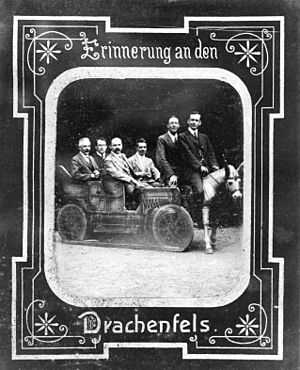John William Nicholson facts for kids
Quick facts for kids
John William Nicholson
|
|
|---|---|

Nicholson second from left in the automobile, 1913
|
|
| Born | 1 November 1881 |
| Died | 3 October 1955 (aged 73) |
| Nationality | Great Britain |
| Awards |
|
| Scientific career | |
| Fields | Mathematician |
John William Nicholson (born November 1, 1881 – died October 3, 1955) was an English mathematician and physicist. He was a FRS, which is a big honor for scientists.
Nicholson is known for being one of the first to create an early model of the atom. His model suggested that the tiny parts inside atoms, called electrons, move in specific, fixed ways. This idea was a very important step in understanding how atoms work.
He also helped explain how light is given off when electrons move closer to the center of an atom. This helped scientists understand the light patterns, called spectral lines, that come from things like the Sun and distant nebulas. Another famous scientist, Niels Bohr, even mentioned Nicholson's work in his important 1913 paper about the Bohr model of the atom.
Discoveries and Ideas
Nicholson used astronomy and spectroscopy (a way to study light) to look at nebulas in space. In 1911, he thought he found signs of new, unknown elements. He even gave them names like Coronium and Nebulium.
However, later on, another scientist named Ira Sprague Bowen discovered what these "new elements" actually were. They turned out to be doubly ionized oxygen, which is a form of oxygen we already knew about. Even though his idea about new elements was not quite right, Nicholson's work was still very important. It helped other scientists develop better ideas about how atoms work.
Awards and Honours
John William Nicholson received several important awards for his scientific work. In 1917, he was chosen as a Fellow of the Royal Society of London. This is a very high honor for scientists in the United Kingdom. In 1919, he also won the Adams Prize, which is given for important work in mathematics.

